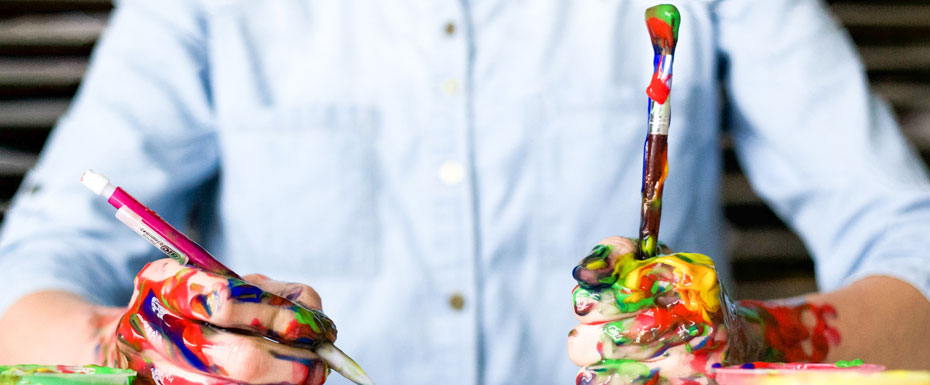
Stationery manufacturers produce dozens of colored pencils, capillary pens, markers, and paints. How can a novice artist not get lost among such splendor? Read my beginner tools overview and decide what tool is the best for your art.
Beginner artists need quality tools and materials to make painting enjoyable. First of all, purchase black pencils of different hardness and a good eraser, which will allow you to remove unnecessary lines and reduce the intensity of a color or work out white strokes. When it comes to graphite pencils, beginners need 2B and 4B hardness types, soft and easy to use.
Colored Pencils

This tool can be considered to be the most suitable for beginners because it is simple to master. Sharpened colored pencils let you work out small details; with a dull pencil, it’s easy to fill in your drawing background or large areas.
To get a more intense shade, you can increase the pencil’s pressure or apply several paper layers. You can also create new shades by using different colors on each other. As a rule, the lower layer should be lighter.
Watercolor pencils should be mentioned separately. They represent a kind of dry watercolor paints, which are made in a pencil form. They are softer than regular pencils, so the colors are more intense and blend better. There are two ways to use watercolor pencils. You can moisten a pencil and then paint, or you can sketch it first and then wash it with a wet brush.
Metallic Colored Pencils

Many manufacturers produce colored pencils with a Metallic effect. They are presented both in the middle price segment and in the expensive series. Metallic-effect pencils draw well on white paper, conveying the sparkling glare, glow of water drops, and steel gloss. Drawings with such pencils on a black background look very impressive. You can even buy a sketchbook with black pages where the drawings will look like engravings.
Metallic colored pencils combine perfectly with ordinary pencils; you can even lay them on top of each other. It’s unnecessary to draw metal objects ultimately with such pencils because the image might turn out flat. Imitation of metal is obtained when an item is drawn with ordinary colored pencils and with the help of “metallic” set accents.
Metallic pencils shouldn’t be fixed; even with special fixatives’ help, the color will be dim. It’s better to use a fixative spray before applying the first layer.
Neon Colored Pencils

The lines of many manufacturers also contain neon pencils. Typically, these are small sets presented with neon pencils in orange, blue, pink, and green tones. It’s a tool for children’s art because, in standard lighting, neon shades are almost invisible, even if they are applied in several layers. But putting this drawing in front of an ultraviolet lamp will create a pleasing optical effect. Besides, neon pencils are brighter on kraft paper.
Wax, Oil, and Dry Pastel

There are different types of pastels, which are different from each other by their ingredients. The two main types are dry and oil pastels. Dry, in turn, is divided into soft and hard. The softest color is the pale pastel, which is easy to apply and rub on the surface, but it crumbles heavily.
The hard pastel contains less pigment and does not crumble as much. However, both types of dry pastels have a rather complicated drawing technique, so they are not suitable for all beginners. Especially since the pastel is short-lived, its layer breaks down quickly, and particular treatment is needed to preserve it.
An oil pastel differs not only in its saturation but also in the transparency of its color. It contains oil as a binding agent, which ensures its properties. Oil pastel can be used both by beginners and experienced artists working in such techniques as sgraffito (scratching) and impasto (relief painting).
Wax pastels are wax crayons mixed with pigments. They can not be sharpened, so it is impossible to use such crayons to work out the details. On the other hand, they can quickly and easily fill up the background and sometimes create a spectacular bumpy surface texture. The colors are very intense and saturated. The pigment is considered more resistant than in other types of pastels.
Markers for Sketches
In many ways, this tool resembles felt-tip pens but differs from them by its broader creative possibilities. Usually, it’s a double-sided instrument; on the one side, there is a tip in the form of a brush, and on the other, there is a flat tip, typical for markers.
This tool allows you to work through details and fill large areas with color. The colorless blender marker makes it easy to mix colors.
This type of marker is filled with water-based ink. Some artists use alcohol markers on top of it to create original effects.
Fountain Pens, Liners, Rapidographs

In the past, to obtain a clear and expressive contour, a dense line, or a contrasting image, people used a feather or brush, which was dipped into ink. Nowadays, such lines are more convenient to create with capillary pens and liners.
In some art supply stores, you can find a separate category – radiographs. From a technical point of view, fountain pens are one of the types of radiographs. They also consist of a tank for paint, a unique tube, valve, and needle. But they can’t write at an angle, but for another type of rapidograph, for isograph, it’s a feasible task.
When using a fountain pen, the tip should be kept almost perpendicular, in extreme cases – at a small angle. It’s not allowed to apply pressure on it as the thin tip breaks easily. Fountain pens are used to draw little details.
Liners are, in fact, a simplified version of a rapidograph. They allow to draw contrast thin lines, so they are usually used for such techniques as doodling and zentangles. Comics artists use them. Compared to rapidographs, the writing nodes of liners are more durable. But the rods are still sensitive, so you can’t push on them. Liners contain water-based inks with higher color intensity, so the shades are highly saturated.






